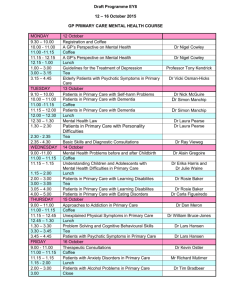STRATEGIC MARKETING ISSUES Seminar Outline PROERA
advertisement
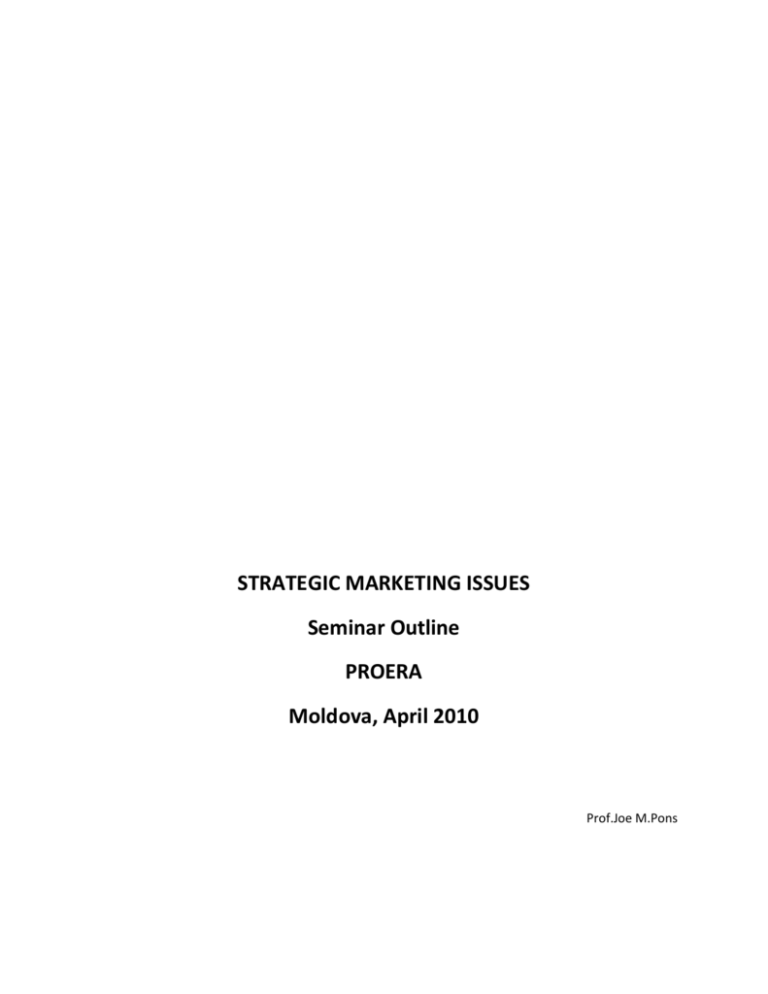
STRATEGIC MARKETING ISSUES Seminar Outline PROERA Moldova, April 2010 Prof.Joe M.Pons INTRODUCTION The Seminar on Strategic Marketing Issues takes place over an intensive 5 day period. Both time limitations and the relative complexity of the issues to be tackled will present a number of challenges that everyone must be aware of in order to make it a worthwhile learning experience. I am convinced that the level of motivation will overcome potential difficulties as we go along. This note will give you some hints on how to make the most out of this experience as well as provide a detailed overview of the path that we are going to travel together. Being a program on Marketing Management issues (note the underlining!!), cases will be the primary material, together with a set of some supplementary readings which will be handed out in class. Copies of slides will also be made available. For the sake of structure, each day will unfold a particular theme, helping participants to focus on the groups of issues to be analysed. Timing considerations will require us to gather speed rather quickly and to make the most out of the available number of classroom hours. In order to optimise the learning experience good level of class (case) preparation is of the essence. The word “intensive” used in the first paragraph must be taken in a literal sense. OBJECTIVES This Seminar has been designed with the objective of helping the students develop a conceptual framework (their own) covering the basic variables that come to play when companies make decisions related to the generation or development of business opportunities. We will try, in other words, to structure your thinking when approaching a marketing problem. The number of concepts we shall be dealing with is not large by any means and none of them requires deep reflection to be grasped. They will only become really useful -however- in so far as the participant learns to interrelate them in a coherent manner -as the course evolves. This is where the cases become irreplaceable, as they build on a series of gradually more complex business decisions. As participants will realise this is more a course on how to manage the marketing function than a transmission of marketing concepts and buzzwords. Thorough understanding of the concepts -at a theoretical level- will not be sufficient unless a framework -a methodology that makes analysis more rigorous and straightforward- is built up that encompasses these concepts. Framework building should prove a challenging intellectual task requiring the flexibility to change, adapt and incorporate concepts as we learn to apply them through cases. The fact that the emphasis of this module is on the application of concepts -rather than just theory building- leads naturally to the second objective described below. The cases chosen for the course will always require making decisions, that is, placing ourselves in somebody else’s shoes and making a commitment to a specific plan of action. Helping the students to do so in a way which is consistent with their analysis of the relevant issues in the case constitutes the second objective of this course. In other words we will try to improve the balance between your analytical and intuitive capabilities, realising that effective management combines both in order to truly excel at the business generation phase (this is what deep down marketing is about). Decisions will be approached from a general management perspective, keeping a broad view as it is required in a Program like the one you are following. Achievement of the above objectives to a degree which is perceived as sufficient makes frequent participation in class discussion absolutely essential and careful listening to each other’s opinion even more so. PREPARING FOR CLASS Becoming familiar with the case method might -in some cases- prove a difficult task. There is no “best way” to prepare a case but some comments might be useful as mere suggestions to “get acquainted” as quickly as possible with a methodology you will be using throughout the Program in many different ways. Many students find it useful to skim quickly through a case a few days before it’s due; look at the first and the last paragraphs, main headings and exhibits to get a general idea of the type of problem you are confronted with and the information available. You will then start the actual preparation in a much better position to identify relevant factors and summarise them in a manageable number of pages (one or two). When preparing the case some kind of structure must be used to group the issues; a simple framework is provided in the readings distributed before the first case session and I encourage you to use it. It is unlikely that a “decent” preparation can be completed in less than two hours (Yes, it says two hours!!). To check for the quality of your individual work you can try and write down your action plan in specific terms. When looking at it some questions will still crop up and a few assumptions will be tested. In case it does not happen, you may reconsider the quality of your own preparation effort. To complete preparation for the class session, group discussion of the case is essential. Group consensus on specific action plan for each case is neither required nor desirable. Instead use the group to sound out ideas, check basic analytical issues and try your hand at persuading a small number of people. Some time will be available each day for group discussion of the cases assigned. ADMINISTRATIVE ISSUES I will be here on a full time basis (at least as much as you are) so I can honestly say that my availability will be pretty high; please do not hesitate to come and ask for help, guidance or just exchange of ideas at any time. I can also be contacted through e-mail (I promise 48 hour response…!) at joepons@yahoo.es It is my hope that the educational experience that we are going to share will increase your appetite for further modules in the Program. Tuesday April 13th Theme: Market Analysis: Customers, Competitors and Channels 9.00 – 10.30 Introduction to the course Objectives and teaching methodology 10.30 – 11.15 Group work Group discussions of the first case assigned for the day 11.15 – 11.30 Coffee Break 11.30 – 12.45 Market Analysis: Diagnosing market problems/needs and setting short term action plans. Case: Aqualisa Quartz; Simply a Better Shower 12.45 – 14.15 Lunch 14.15 – 15.00 Group work (2nd case) 15.00 – 16.30 Managing the value proposition in a competitive setting; finding ways to create value. Price –vs- value orientation Case: Tweeter 16.30 – 16.45 Break 16.45 – 17.30 Putting together the learning points of the day Conceptual Wrap up Wednesday April 14th Theme: Value creation: Positioning and Pricing 9.30 – 10.15 Morning starter Understanding Value Creation and Differentiation as the Pillars of any Business Proposition 10.15 – 11.00 Group preparation of the first case 11.00 – 11.15 Coffee break 11.15 – 12.45 Reflecting Value on Pricing Decisions: Criteria for pricing new and innovative products Case: Curled Metal; (9-709-434) 12.45 – 14.15 Lunch 14.15 – 15.00 Group preparation of the afternoon case 15.00 – 16.30 Market Positioning and Repositioning; Putting it all together (1) Case: Raymond Mushrooms Corporation We are going to use this case as an integrative exercise of the whole range of marketing decisions covered so far. The first part of the discussion will be the economics of the situation, ie. the numbers; you are asked to look into the economics of RMC’s situation, with a view to identifying the reasons behind its poor economic health. After this, please calculate the profitability impact of the branding proposal, looking at the new breakeven point. Having done the above, we will broaden our analysis of the case to include all the marketing variables which complement our earlier discussion. That second part will probably take place on Thursday morning The following questions may be useful guidelines for the whole analysis 1.- How do you assess RMC's situation? 2.- What are the sources of the present problems? 3.- How will the proposed new branding strategy help solve the problems identified above? 4.- What changes -if any- would you make and how would you implement them? 16.30 – 16.45 Coffee break 16.45 – 17.30 Wrap up lecture: Basic Frameworks to Measure and Ensure Customer Orientation Thursday April 15th Theme: Effective Delivery of Value; Managing Market Intermediaries and Customer Relationships 9.30 - 10.15 Value, Value and Value: Design it, Differentiate it and eventually...Extract it 10.15 – 11.00 Group Discussion of the case assigned for today 11.00 – 11.15 Coffee Break 11.15 – 12.45 Implementation Requirements of a Repositioning Exercise in the Light of Business Objectives Case: Raymond Mushrooms (2ndpart) 12.45 – 14.15 Lunch 14.15 – 15.00 Group Discussion of the afternoon case 15.00 – 16.30 Managing Key Customer Interactions Case: CMR Industries 16.30 – 16.45 Coffee Break 16.45 – 17.30 Wrap up and summary of the learning points Friday April 16th Theme: Sales Policies and Marketing Structures 9.30 - 10.15 Morning Starter 10.15 – 11.00 Group Discussion of the case assigned for today 11.00 – 11.15 Coffee Break 11.15 – 12.45 Managing Sales Teams: Key in Strategy implementation Case: Cabot Pharmaceuticals 12.45 – 14.15 Lunch 14.15 – 15.00 Group Discussion of the afternoon case 15.00 – 16.30 Interfunctional coordination to ensure proper customer contact and delivery Case: Ti Tech (A) 16.30 – 16.45 Coffee Break 16.45 – 17.30 Wrap up and summary of the learning points Saturday, April 17th Saturday April 17th Theme: Marketing Communications; Strategic perspective 9.30 – 10.15 Morning Starter: Putting finishing touches 10.15 – 11.00 Group preparation of the first assigned case for the day 11.00 – 11.15 Coffee Break 11.15 – 12.45 Managing Marketing Communications; Priorities and Tradeoffs Case: Culinarian Cookware 13.00 – 14.30 Advertising, Promotions and the Rest of the Elements of Marketing Communications Budgets; Criteria for Relative Emphasis 14.30 Closing of the Seminar
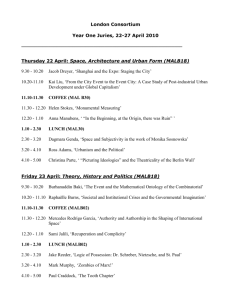

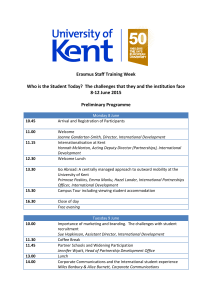
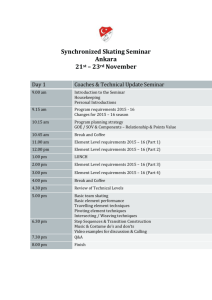
![저기요[jeo-gi-yo] - WordPress.com](http://s2.studylib.net/store/data/005572742_1-676dcc06fe6d6aaa8f3ba5da35df9fe7-300x300.png)

